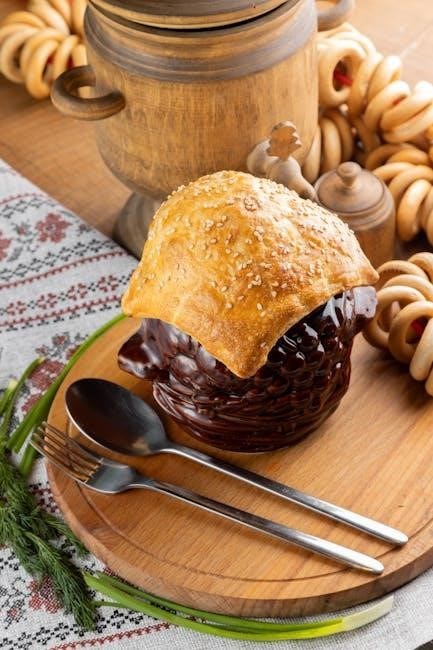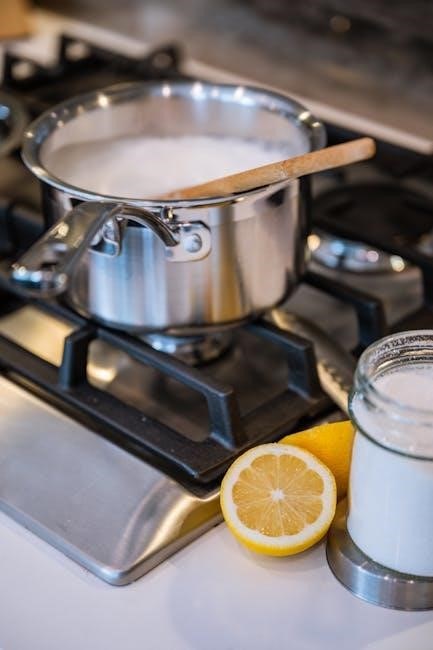Welcome to your Instant Pot Dutch Oven manual, your guide to mastering this versatile 5-in-1 multi-cooker. Discover how to unlock its full potential for perfect cooking results every time.
Overview of the Instant Pot Dutch Oven
The Instant Pot Dutch Oven is a 5-in-1 electric multi-cooker designed to simplify cooking with precision and versatility. It features an enameled cast iron insert for even heat distribution and durability. With functions like sear/sauté, braise, slow cook, and manual mode, it offers flexibility for various recipes. The appliance supports two manual mode options: one for low-temperature, long-duration tasks like slow cooking or sous vide, and another for high-temperature cooking. Its intuitive control panel allows precise temperature adjustments, making it ideal for both novice and experienced cooks. This Dutch oven combines traditional cooking methods with modern convenience, ensuring consistent results for dishes like braised meats, stews, and roasted vegetables.
Key Features and Functions
The Instant Pot Dutch Oven offers a range of features that enhance cooking versatility. Its enameled cast iron insert ensures even heat distribution and durability, while the 5-in-1 functionality allows for searing, sautéing, braising, slow cooking, and manual mode. Manual mode provides two options: one for slow cooking, sous vide, or dough proofing at lower temperatures with longer cooking times, and another for high-temperature cooking. The appliance also features precise temperature control, allowing for adjustments to suit various recipes. Additionally, the Dutch oven includes a keep-warm function and a user-friendly interface for easy operation. These features make it ideal for preparing a variety of dishes, from hearty stews to perfectly cooked meats and vegetables, ensuring consistent and delicious results every time.

Understanding Manual Mode
Manual Mode offers two options: one for slow cooking, sous vide, or dough proofing at lower temperatures, and another for high-temperature cooking, providing flexibility for various recipes.
Manual Mode 1: Slow Cooking, Sous Vide, and Dough Proofing
Manual Mode 1 is ideal for slow cooking, sous vide, and dough proofing. It operates at lower temperatures, typically up to 203°F, with cooking times up to 12 hours. Perfect for recipes requiring gentle heat, this mode ensures even cooking for tender results. For sous vide, set a precise temperature to achieve consistent doneness. Dough proofing benefits from the controlled environment, promoting even yeast activation. Use this mode for dishes like braised meats, stews, or rising bread dough, allowing you to achieve professional-quality outcomes with minimal effort. Adjust the temperature and time easily to suit your recipe needs for perfect results every time.
Manual Mode 2: High-Temperature Cooking
Manual Mode 2 is designed for high-temperature cooking, perfect for searing, browning, and achieving a crispy texture on dishes like seared steaks or roasted vegetables. This mode allows you to cook at temperatures up to 235°F, making it ideal for recipes that require intense heat. Use Manual Mode 2 to quickly cook meats, ensuring a nice crust forms, or to roast vegetables to perfection. The higher heat setting also works well for recipes like paninis or crispy hashes. For optimal results, flip food halfway through cooking to ensure even browning. This mode is a great way to replicate the results of traditional high-heat cooking with the precision and control of your Instant Pot Dutch Oven.

Cooking Techniques with the Instant Pot Dutch Oven
Explore versatile cooking techniques like searing, braising, slow cooking, and sous vide. Achieve perfect results with precise temperature control and even heat distribution for a wide variety of dishes.
Sealing, Searing, and Braise Functions
The Instant Pot Dutch Oven excels in sealing, searing, and braising, allowing for rich, flavorful dishes. Use the sear/sauté function to brown meats or vegetables, enhancing depth of flavor. The braise function combines high heat searing with a slow simmer, perfect for tenderizing tougher cuts of meat. For sealing, ensure the lid is tightly closed during cooking to trap moisture and flavors; These functions work seamlessly together, making it easy to achieve restaurant-quality results at home. Experiment with different techniques to elevate your cooking and create hearty, delicious meals with minimal effort.
Slow Cooking and Simmering
The Instant Pot Dutch Oven offers exceptional slow cooking and simmering capabilities, perfect for tenderizing meats and developing rich flavors. Use the slow cook function for dishes like stews or roasts, with adjustable temperatures and times to suit your recipe. The simmer function maintains a gentle heat, ideal for soups, sauces, or delicate dishes. For best results, layer ingredients and add sufficient liquid to prevent drying. Experiment with manual mode to customize settings, ensuring a perfect balance of flavor and texture; This feature is ideal for hands-off cooking, allowing you to prepare hearty meals with minimal effort and precise control.

Converting Dutch Oven Recipes to Instant Pot
Adapting Dutch oven recipes for the Instant Pot involves adjusting cooking times and settings. Use manual mode for precise control, ensuring dishes cook evenly and efficiently.
Adjusting Cooking Times and Settings
When converting Dutch oven recipes to the Instant Pot, it’s essential to adjust cooking times and settings. Manual mode offers precise temperature control, allowing for tailored cooking experiences. For slow cooking, sous vide, or dough proofing, use Manual Mode 1, which operates at lower temperatures with longer cooking times. For high-temperature cooking, such as searing or braising, Manual Mode 2 is ideal. Typically, Instant Pot recipes require 30-50% less time than traditional Dutch oven methods. For example, a 2-hour Dutch oven recipe might take just 30-40 minutes in the Instant Pot. Always refer to the manual for specific guidance on temperature adjustments and cooking durations to ensure optimal results.
High-Pressure vs. Traditional Dutch Oven Cooking
The Instant Pot Dutch Oven offers high-pressure cooking, significantly reducing cooking times compared to traditional Dutch oven methods. High-pressure mode is ideal for tougher cuts of meat and hearty stews, achieving tender results in a fraction of the time. Traditional Dutch oven cooking, on the other hand, relies on slow, even heat for dishes like bread or delicate sauces. While high-pressure cooking is faster, it may not be suitable for all recipes. For example, slow-cooked dishes requiring precise temperature control are better suited for traditional methods. Always consider the recipe’s requirements when choosing between high-pressure and traditional cooking modes. Consult the manual for specific guidance on achieving the best results for your dish.

Popular Recipes for the Instant Pot Dutch Oven
Explore a variety of delicious recipes, from tender braised meats to hearty stews and roasted vegetables, all perfectly cooked in your Instant Pot Dutch Oven.
Braised Beef and Pork Loin Recipes
The Instant Pot Dutch Oven excels at creating tender, flavorful braised beef and pork loin dishes. For a perfect pork loin, use Manual Mode 2 at 235°F for 2 hours, flipping halfway. Ensure the internal temperature reaches 165°F for doneness. For braised beef, opt for high-pressure cooking, achieving fall-apart texture in just 90 minutes. Both recipes yield rich, savory results with minimal effort, making them ideal for special occasions or hearty family meals.
- Use Manual Mode 2 for high-temperature braising.
- Ensure meat reaches safe internal temperatures.
- Perfect for tender, flavorful results every time.
- Use Manual Mode 1 for slow, even cooking.
- Sauté veggies first for enhanced flavor.
- Layer ingredients for stews and braises.
- High-pressure settings reduce cooking time.
Vegetable and Stew Cooking Guidelines
The Instant Pot Dutch Oven is perfect for simmering vegetables and hearty stews to perfection. Use Manual Mode 1 for slow cooking at lower temperatures, ensuring tender results. Sauté vegetables first for added flavor before switching to simmer mode. For stews, layer ingredients like meat, veggies, and broth, then cook covered on Manual Mode 2 for high-temperature braising. Achieve even cooking by cutting vegetables uniformly and layering them properly. For quicker results, use high-pressure settings, reducing cooking time significantly while retaining flavor and texture. The Dutch Oven’s precise temperature control ensures your dishes are cooked to perfection every time.

Cleaning and Maintenance
Clean your Instant Pot Dutch Oven by washing it with hot soapy water and drying thoroughly after each use.
Regular maintenance ensures longevity, including deep cleaning and proper storage.
General Cleaning Instructions
Regular cleaning is essential to maintain your Instant Pot Dutch Oven’s performance and hygiene. After each use, wash the pot with hot soapy water and a soft sponge. Avoid using abrasive cleaners or scrubbers, as they may damage the enamel coating. Rinse thoroughly and dry with a soft cloth to prevent water spots. For tougher residue, soak the pot in warm water before cleaning. Always clean the lid and handles as well. Regular maintenance ensures your Dutch oven remains in excellent condition for years of reliable cooking. Proper cleaning also prevents food odors and stains from building up over time. Keep your Instant Pot Dutch Oven clean and ready for its next use.
Deep Cleaning and Oven Maintenance
For deep cleaning and maintenance, mix equal parts water and white vinegar in the Dutch oven. Bring to a simmer on the sauté function for 10 minutes to loosen tough residue. Scrub with a soft sponge and rinse thoroughly. Avoid harsh chemicals or abrasive cleaners, as they can damage the enamel. For stubborn stains, apply baking soda paste and let it sit overnight before rinsing. After deep cleaning, dry the pot with a soft cloth to prevent water spots. Regularly seasoning the pot can also enhance durability. Store the Dutch oven in a dry place to avoid rust. Proper maintenance ensures optimal performance and longevity of your Instant Pot Dutch Oven.

Troubleshooting Common Issues
Check power supply, ensure lid seals properly, and verify temperature settings. Consult the manual for error codes and solutions to address common operational issues effectively.
Temperature Control and Mode Selection
Mastering temperature control and mode selection is essential for optimal cooking with your Instant Pot Dutch Oven. The appliance offers two manual modes: Mode 1 for slow cooking, sous vide, and dough proofing at lower temperatures (up to 203°F) with longer durations, and Mode 2 for high-temperature cooking (up to 235°F) suitable for searing and braising. To adjust settings, press the Time/Temp button until the desired temperature blinks, then use the control panel to set your preferred parameters. Ensure the lid is sealed properly to maintain consistent temperatures. Refer to the manual for specific guidelines on mode selection and temperature adjustments to achieve perfect results for your recipes.
Common Errors and Solutions
When using your Instant Pot Dutch Oven, common errors can occur, such as improper lid sealing or overfilling. To avoid these, ensure the lid is aligned correctly and the pot is not filled beyond the max line. If the display shows an error code, refer to the manual for troubleshooting. Another issue is sudden temperature drops; always allow natural pressure release before opening. For uneven cooking, stir ingredients midway. If the oven doesn’t heat, check the power connection and ensure the base is clean. Regular cleaning prevents residual buildup. Addressing these issues ensures smooth operation and optimal cooking results, helping you make the most of your Instant Pot Dutch Oven.
